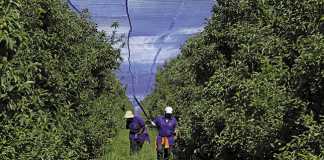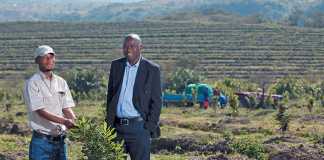Trade liberalisation has resulted in huge market expansion for South African fruit. It has, however, also resulted in numerous new challenges for producers. Glenneis Erasmus reports.
The huge international market explosion, due to trade liberalisation combined with deregulation, resulted in a boom of export companies. In the past, everything was regulated and exported through one body, then suddenly 10 years ago, producers could choose from thousands of exporting companies. But this proliferation is still a headache in the fruit sector, according to Anton Rabe, CEO of the Deciduous Fruit Producers Trust (DFPT).
Instead of coordinating exports and working with other exporting companies to enhance the industry’s competitive edge, many agencies did their own thing, sometimes to the detriment of the industry in general. Now, South African products don’t only have to compete with fruit from other countries, but also have to compete with locally grown fruit, even of the same type and cultivar in the same market. Sometimes a producer even has to compete with his/her own product in different brands.
The situation has stabilised somewhat over the past few years with around 100 exporters per industry (deciduous, citrus and stone fruit). Rabe feels that this is still too many as 20 to 30 of these exporters are responsible for exporting about 90% of the fruit, while the remaining exporters only account for the final 10%. Reducing the number of exporters will help to further streamline the industry and ensure better cooperation and a healthy exchange of information, according to Rabe.
There have also been a few horror stories of fly-by-night companies that disappeared with producers’ fruit without paying them. Today, a few producers still burn their fingers with export companies, but export companies also experience their fair share of problems, according to Rabe. He recalls an incident where a farmer received advances in payment from four companies for the same fruit yield. When the time came to deliver, the farmer was simply was unable to.
Minimising the risks of exporting
E xporting, however, no longer has to be as risky as it was 10 years ago. The Fresh Produce Exporters Forum (FPEF), in conjunction with various grower bodies, has created a self-regulating policy for its members. The policy includes mediation and conflict management procedures to help resolve disputes between producers and export agencies. The arrangements also mandate the use of an impartial third party as mediator to ensure an unbiased solution. The forum stipulates a strict code of conduct that compels its members to conduct their business with integrity and in a transparent and honourable manner. It also has clear requirements for the information and arrangements contained in contracts between producers and export agencies. Agencies are not obliged to be members, and not being a member does not imply that the agency is inferior to those that are members. Rabe, however, advises producers who make use of exporters that are not members to ensure that these agencies comply with the practices adopted by the FPEF, and insist on written arrangements that spell out the responsibilities of both parties. He adds that producers should not chop and change or use many different agencies because it’s better to build a trust relationship with one agency – where both parties know that the other will look after its interests, especially during hard times.
Another way to reduce risk is to shift from a consignment basis to a fixed-price transaction. “Most agencies still operate on a consignment basis,” Rabe says. “Producers in effect carry almost all the risk until the fruit is delivered to the country of destination. There is also little motivation for agencies to keep costs down while commission is calculated after costs have been incurred.” He explains that exporters often receive rebates on consignments. “If you are unaware of rebates then the agency might end up pocketing the money for itself,” Rabe says. He believes that using a fixed-price transaction or differentiated commission structure to cater for different market conditions and associated risk-reward ratios, would help to add transparency and reduce producer risk. The farmer might, under some circumstances, earn less money than somebody who carries the risk to the end, but he/she might also earn more as the exchange rate and markets are extremely volatile and sometimes boil down to a lottery.
Strength in numbers
Producer consolidation is another method of enhancing negotiation power with export agencies. “Numerous producers have grouped themselves together and export all their fruit via one export agency,” Rabe says. “The increased volumes have helped them to negotiate better prices and agreements. Some growers also make use of forward integration into the value chain, while exporters integrate backwards into supply and forward into the logistical system.” The industry is currently creating a benchmark model that will enable producers to compare their returns with those of other farmers.
The model will be released later this year for some of the sub-sectors and will provide information concerning volumes and prices attained in each market for each fruit type. A producer who performs better than the benchmark can’t complain, but performing below the benchmark will create a cause for investigation. “We must empower producers to ask the right questions and create greater transparency in the export chain,” Rabe says. “Producers must ask why they earn less than their peers and reasons must be given. Sometimes there will be good reasons for certain returns, such as fruit quality, or the specific segment or time period in the market. Agencies that cannot provide these answers might be taking advantage of farmers.” Contact Anton Rabe on (021) 870 2900, Maarten van Alkemade on (011) 631 1504, or Justin Chadwick on (031) 765 2514. |fw
Managing market volatility
Price volatility, due to volatility in the exchange rate and international supply and demand, has a huge impact on producers’ earning and financial planning. Jacques du Preez, agricultural economist from Optimal Agricultural Business Systems, says that it’s not only the gross price that is affected by the volatile exchange rate, but other costs too, such as shipping.
He points out that the price for a carton of fruit with a market price of 7,80 euros would realise a gross of R63,18 if the rand trades at R8,10 to the euro, whereas the gross price would be around R74,88 per carton. (These are hypothetical values as companies’ cost structures differ and vary according to market agreements.)
With the weaker rand, import duties, importer’s commission and overseas handling, as well as cost insurance and freight, free on board will more likely be R9,60 to the euro instead of R8,10, resulting in delivered in port prices of R46,51 instead of R38,96. Fruit producers can make use of forex hedging to reduce price volatility due to the exchange rate, according to Maarten van Alkemade, director of trade and finance: Corporate and Investment Banking at Standard Bank.
The futures market can also be used to hedge market prices for some agricultural commodities, such as grain. Such a mechanism has unfortunately not yet been developed for the fruit industry. Market risks can further be reduced by making use of framework contracts. “These contracts stipulate everything involving the agreement between the buyer and seller, from the quantity and quality, to the time and method of shipping and time and method of payment,” Van Alkemade says. “It does not, however, stipulate the price, which depends on supply and demand.”
Producers in effect have a secure market for the stipulated product and this translates into better production, market and financial planning than would be possible without such a contract. Van Alkemade adds that a close relationship with a buyer, the ability to supply a premium-quality product and to maintain supply can in some cases provide producers with a better negotiation advantage.
Farmers will, however, still remain price-takers due to the huge oversupply of fruit in the market – consumers would rather switch to other fruit types if the price of one type is not in line with what they are willing to pay.
Challenges of trade liberalisation
Trade liberalisation might have created new market opportunities, but it also created new challenges to producers. Complying with countries’ food safety requirements is one such challenge. Countries often change food safety regulations ad hoc with little prior warning provided to exporting countries.
The industry therefore has to be alert and continually monitor these trends, communicating them to farmers to ensure their production methods comply with these regulations. Non-compliance can lead to the industry losing its entire market share. Phytosanitary regulations are another challenge. In addition to preventing the spread of pests and diseases, as was initially intended, these regulations are now also used to create trade barriers or defer trade, according to Justin Chadwick, CEO of the Citrus Growers Association. He says South Africa has been struggling for over 12 years to get access to the Japanese market for clementines, despite there being no risks associated with the fruit. Japan already imports around five-million cartons of other citrus from South Africa annually. Another example is the recognition of pest-free or low-prevalence areas of production. All these terms are well defined and standardised. Even so, the US recognises certain areas in the Western Cape and Vaalharts as free of citrus black spot, while the EU does not. “You have to submit details, be subject to inspections and await a number of meetings to decide if this status can be accepted if you want to export citrus to the EU,” Chadwick says. “Our applications have been met with requests for more detail and when we submit these requirements, we are confronted with even more questions and challenges.” He adds that this becomes even more absurd as research has shown that the EU is not susceptible to black spot due to its climatic conditions.
Chadwick believes that the biggest risk facing South African fruit growers is not hail, frost, drought, fuel prices or exchange rates, but that some ill-equipped official at a border post would prod a dead larvae and decide that it “appears to be alive.” One such incident cost South African citrus growers over R20 million in 2005 due to a halt in imports and the disruption in trade in that specific market. Chadwick points out that the indirect consequences are even greater, as other trading partners initiate similar ban when such an incident occurs.













